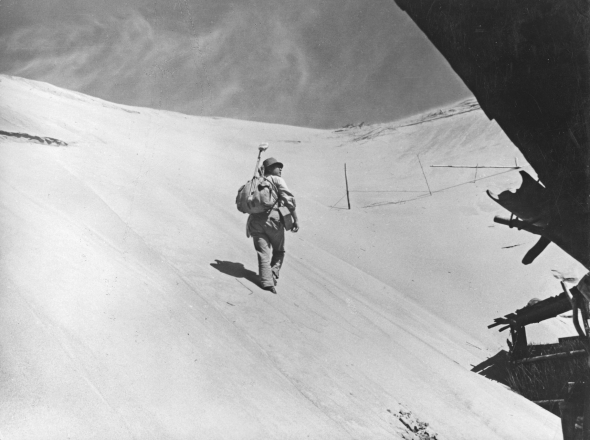Woman in the Dunes: Shifting Sands
By Audie Bock
Of the varied media the artist Hiroshi Teshigahara mastered, filmmaking is the one he let go. Upon the death of his headmaster father, in 1979, he assumed the full responsibility of leadership of the Sogetsu flower arrangement school, in which his sister had been far more active than he. He would return to film in later years, as the revered headmaster himself, but in a far more solemn and far less sensual mood than that which marked his greatest, earlier works.
The feature film Woman in the Dunes, his 1964 collaboration with novelist-playwright-scenarist Kobo Abe, stands at the high point of his filmmaking career and constitutes the most eloquent of his several works with Abe. Using the textures of his pottery and the grand scale of his floral constructions, Teshigahara brings to Abe’s text the full force of his nonverbal artistry of chiaroscuro, of shapes and surfaces, of speed and languor. From his work as a potter, which harks back to the gently curved shapes, rough surfaces, and muted glazes of vessels associated with the refinements of a late sixteenth-century Japanese tea ceremony, he lends a sculptural beauty to the sands of Woman in the Dunes, bringing them to life as a key player in the drama of a man and a woman pitted against the elements and each other. As the heir to Sogetsu, one of the world’s foremost schools of ikebana flower arrangement, Teshigahara moves between the extreme delicacy of an art-alcove vase for setting off a hanging scroll painting and the imposing drama of gigantic blooming forests constructed on a stage and animated with moving lights and music. Woman in the Dunes, set almost entirely in a single house, shows both his powerful staging and his love of fine, almost microscopic, detail. Add to all this the brilliantly expressive yet nonintrusive score by Japan’s most distinctive film-music composer, Toru Takemitsu, and every cinematic element combines to support the powerful interaction of a stranger who misses the last bus out of an isolated village and the widow in need of a helper who accepts him as a gift from the collective.
Yes, this is a story about identity, but it is a very Japanese and peculiarly Kobo Abe–esque approach to the subject, where the identity sought is not only that of the individual in personal relationships but, at the same time, that of the group/family/village in opposition to the greater society. Japanese identity is layered in that way. It comes in concentric circles. Abe always examines the individual for comfort level in his society: Is his family or job oppressing him? Does he feel any connection with or loyalty to the group he claims to be part of? And the most important question pervading the writer’s work, whether it is in his other collaborations with Teshigahara, such as Pitfall (1962) or The Face of Another (1966), or in his stage plays, such as Friends: what kinds of bonds with the group does the individual find positive and meaningful as opposed to constricting and demeaning?
These issues, so vivid in the mid-1960s for Teshigahara and other filmmakers, who faced the new phenomenon in postindustrial Japan of ordinary people going missing, seemingly without provocation or foul play, never to be seen again (Shohei Imamura’s documentary A Man Vanishes, from 1967, is another such study), have lost none of their relevance today. For a nation of islands that was unified only by a police state that required a passport to travel from one region to another for nearly three hundred years, where marriages are consummated after thorough detective-agency investigation of family, health, education, and professional records, where even now an individual’s new address is verified within days by a visit from the policeman from the corner kiosk, the impulse to drop out remains extremely powerful. If today’s dropouts simply remain at home, doing nothing but surfing the Internet and eating food shoved under the door, they are still rejecting the perennial demands of ordinary Japanese life for an identity of belonging.
Woman in the Dunes states its premise early, through the design of the opening credits. Cast and crew names are decorated with fingerprint patterns and the imprints of seals bearing the actors’ names in archaic characters—still used instead of a personal signature in Japan as an identifying legal mark. The soundtrack begins with urban noises of trains, car horns honking, and public-address systems blaring. Gradually these blend with the wooden clappers and traditional drums of the classical Bunraku puppet theater. These are the composer’s hints that we are about to move from the cacophony and chaos of modern urban life to something older, deeper, and more melodramatic, and where the characters’ interactions are manipulated by others.
The first cuts in the drama itself introduce the sand in extreme close-up, then gradually withdraw to show the unnamed man, back to the camera, climbing up a towering dune. A high-pitched hum in the score evokes the stultifying heat of the desert and is accompanied by ominous electronic sounds. After a refreshing shot of the distant ocean, the unidentified man’s preoccupation is introduced as he captures a worm on the sand and pops it into his specimen container. An amateur entomologist, he is looking for a variant of a tiger beetle that may get his name in a field guide to the region. He later tells the woman that he is a man who is “only good for catching insects by the tail.” We also see him poking at an insect trying to hide in the sand, and we hear him laughing a little cruelly at its struggle. His self-esteem is clearly lacking.
The first words in the film are the man’s, exclaiming, “This is terrible!” as he nearly stumbles off a cliff of sand onto the roof of a house far below. He gets out his camera to photograph the strange ugliness below him, and a shadow appears across his back, demanding to know if this is an inspection. The man now introduces himself to the questioning villager as a schoolteacher whose specialty is the insects he brandishes in little jars, but he never throughout the entire film gives his name or his place of origin, nor does he speak of his life in the classroom—as if he cared nothing for it.
Taking a rest on the sand, in an abandoned boat on the shore, the man then begins to comment on human relations by rattling off lists of certificates. As an attractive woman’s face is superimposed over his musings, he asserts that men and women live in constant fear of being cheated and therefore constantly produce certificates to prove their innocence. His only directly personal statement is to claim that “you criticized me for arguing too much. But the facts speak for themselves.”
In these few opening minutes, Teshigahara introduces a man whose behavior betrays his insecurity, his lack of satisfaction in his professional life, his ability to be cruel, and his irritating need to dominate or be right when talking to a woman. This unhappy fellow is clearly ripe for a big change, and he is clearly not just the person all his certificates show him to be. When the villager reappears to inform him he has missed the last bus out of the dunes, and he accepts the offer of introduction to a local household to spend the night, his new identity adventure begins.
The sand that so fascinates the man becomes his enemy as he faces entrapment in a house in a hole. The villagers change his identity gradually by calling him first Teacher, then, once he is captive, Helper, and finally, once he has stayed past his three-day leave from his job back home and had sexual relations with his hostess, Your Husband. The woman likewise changes from Granny (or Old Hag) to Mrs. The play of the sand, the wind, the heat and cold, the crows and the water also brings gradual changes to the man’s character. The apparently solid cliff of sand collapses gently but ineluctably under his feet as he attempts to climb out. The sand in the wind becomes a choking, burying monster, combining with the heat to raise a painful rash on the skin. As he observes the scavenging crows and waits with parched lips for the next delivery of water, he becomes humbled by and respectful of the nature that envelops him. Soon the presence of the woman envelops him as well, and their sexual union becomes inevitable. The cinematic presentation of these developments, fluttering between the bestial and the refined, drives the story forward with breathtaking energy.
The villagers, who rank as the puppeteers in the drama—and at one point wear masks to play further on identity questions—provide the intellectual exploration of identity that Abe relishes. It is they who have trapped the man in a pit, at the bottom of a retractable rope ladder. When he rages over the crime of his illegal confinement, what the woman hears is that the women in Tokyo are more beautiful than she is and that there is more to do there. The fact that he has lost his free will does not bother her in the least. She does not worry about who he was (she asks belatedly if he is married and is satisfied when he does not answer); she worries only about how to make him accept his confinement, and she continues to address him as “honored guest.” Just as the meaninglessness of the man’s work is revealed by the fact that no one comes to rescue him, the criminality and amorality of hers is revealed by the fact that the sale of her high-salt-content sand for concrete construction causes buildings to collapse. But as the tensions play out between the two of them and the encroaching sand, neither one of them proves to care about people who are unknown to them (tanin, or “strangers”); it is the two of them and the little village collective that count, right or wrong.
By the end of the film, the man has become involved with other people as never before. He cares most about sharing his new scientific knowledge with the very villagers who have enslaved him, and the woman cares most about keeping this very man who has been meanest and most insulting to her. She was already happy with the larger circle of the village, but her inner circle of family had been emptied by her widowhood. The message about identity is that people need both: the nurturing of daily intimacy and small-group recognition, as in a village or a company or a school, where one’s contribution of labor is appreciated and rewarded. Beyond that circle, both the ancient and the contemporary Japanese feel no deep responsibility, and identity deteriorates into the paperwork of officialdom. Just before the end title, we learn the man’s name and his official status, but by this time we know much better.
























